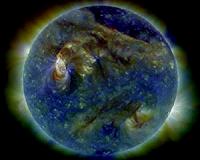 |
Paris (AFP) Dec 29, 2010 The coming year will be an important one for space weather as the Sun pulls out of a trough of low activity and heads into a long-awaited and possibly destructive period of turbulence. Many people may be surprised to learn that the Sun, rather than burn with faultless consistency, goes through moments of calm and tempest. But two centuries of observing sunspots -- dark, relatively cool marks on the solar face linked to mighty magnetic forces -- have revealed that our star follows a roughly 11-year cycle of behaviour. The latest cycle began in 1996 and for reasons which are unclear has taken longer than expected to end. Now, though, there are more and more signs that the Sun is shaking off its torpor and building towards "Solar Max," or the cycle's climax, say experts. "The latest prediction looks at around midway 2013 as being the maximum phase of the solar cycle," said Joe Kunches of NASA's Space Weather Prediction Center. But there is a prolonged period of high activity, "more like a season, lasting about two and a half years," either side of the peak, he cautioned. At its angriest, the Sun can vomit forth tides of electromagnetic radiation and charged matter known as coronal mass ejections, or CMEs. This shock wave may take several days to reach Earth. When it arrives, it compresses the planet's protective magnetic field, releasing energy visible in high latitudes as shimmering auroras -- the famous Northern Lights and Southern Lights. But CMEs are not just pretty events. They can unleash static discharges and geomagnetic storms that can disrupt or even knock out the electronics on which our urbanised, Internet-obsessed, data-saturated society depends. Less feared, but also a problem, are solar flares, or eruptions of super-charged protons that can reach Earth in just minutes. In the front line are telecommunications satellites in geostationary orbit, at an altitude of 36,000 kilometres (22,500 miles) and Global Positioning System (GPS) satellites, on which modern airliners and ships depend for navigation, which orbit at 20,000 kms (12,000 miles). In January 1994, discharges of static electricity inflicted a five-month, 50-million-dollar outage of a Canadian telecoms satellite, Anik-E2. In April 2010, Intelsat lost Galaxy 15, providing communications over North America, after the link to ground control was knocked out apparently by solar activity. "These are the two outright breakdowns that we all think about," said Philippe Calvel, an engineer with the French firm Thales. "Both were caused by CMEs." In 2005, X-rays from a solar storm disrupted satellite-to-ground communications and GPS signals for about 10 minutes. To cope with solar fury, satellite designers opt for robust, tried-and-tested components and shielding, even if this makes the equipment heavier and bulkier and thus costlier to launch, said Thierry Duhamel of satellite maker Astrium. Another precaution is redundancy -- to have backup systems in case one malfunctions. On Earth, power lines, data connections and even oil and gas pipelines are potentially vulnerable. An early warning of the risk came in 1859, when the biggest CME ever observed unleashed red, purple and green auroras even in tropical latitudes. The new-fangled technology of the telegraph went crazy. Geomagnetically-induced currents in the wires shocked telegraph operators and even set the telegraph paper on fire. In 1989, a far smaller flare knocked out power from Canada's Hydro Quebec generator, inflicting a nine-hour blackout for six million people. A workshop in 2008 by US space weather experts, hosted by the National Academy of Sciences, heard that a major geomagnetic storm would dwarf the 2005 Hurricane Katrina for costs. Recurrence of a 1921 event today would fry 350 major transformers, leaving more than 130 million people without power, it heard. A bigger storm could cost between a trillion and two trillion dollars in the first year, and full recovery could take between four and 10 years. "I think there is some hyperbole about the draconian effects," said Kunches. "On the other hand, there's a lot we don't know about the Sun. Even in the supposedly declining, or quiet phase, you can have magnetic fields on the Sun that get very concentrated and energised for a time, and you can get, out of the blue, eruptive activity that is atypical. In short, we have a variable star."
Share This Article With Planet Earth
Related Links Solar Science News at SpaceDaily
 Solar Scientists Discover Physical Mechanism Behind Sympathetic Flares
Solar Scientists Discover Physical Mechanism Behind Sympathetic FlaresPalo Alto CA (SPX) Dec 15, 2010 A serendipitous alignment of high-powered spaceborne solar instruments has finally provided the data allowing scientists to uncover the physical mechanism behind so-called "sympathetic flares" on the Sun. For over 75 years, solar physicists have been observing near-synchronous explosions in the solar atmosphere, and have wondered whether they were somehow related, but hard evidence for con ... read more |
|
| The content herein, unless otherwise known to be public domain, are Copyright 1995-2010 - SpaceDaily. AFP and UPI Wire Stories are copyright Agence France-Presse and United Press International. ESA Portal Reports are copyright European Space Agency. All NASA sourced material is public domain. Additional copyrights may apply in whole or part to other bona fide parties. Advertising does not imply endorsement,agreement or approval of any opinions, statements or information provided by SpaceDaily on any Web page published or hosted by SpaceDaily. Privacy Statement |